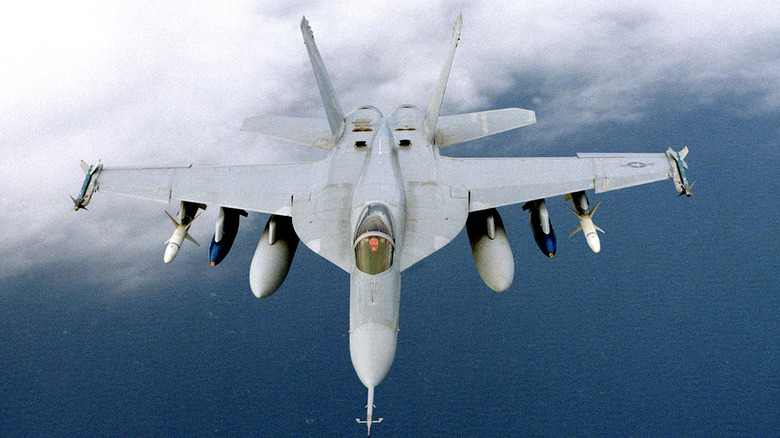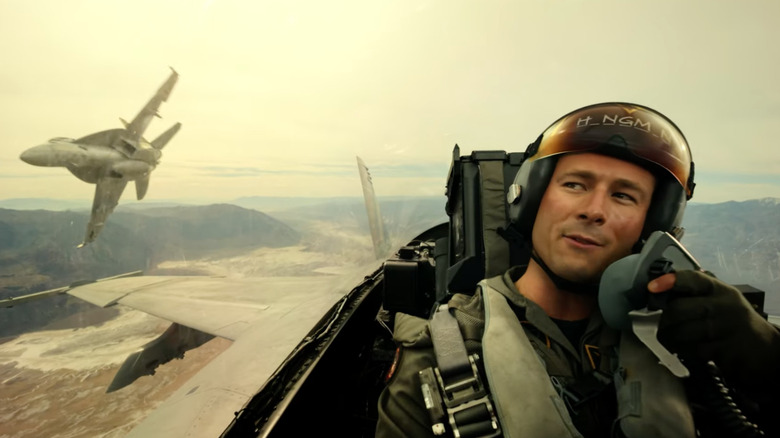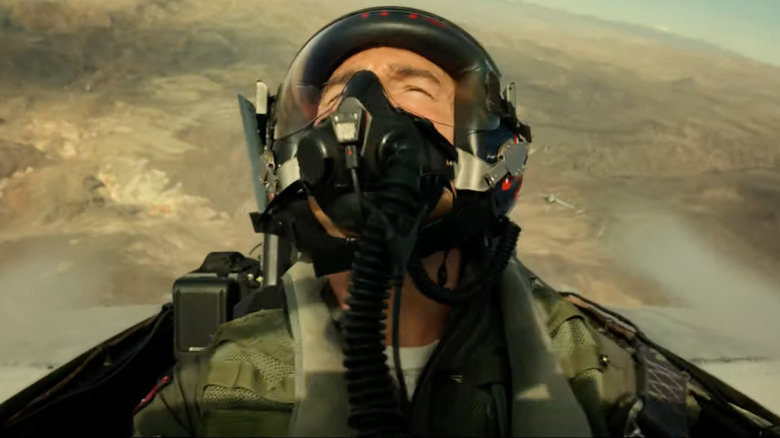The 'Top Gun: Maverick' Scene That's Impossible According To A Fighter Pilot
When the action sequel "Top Gun: Maverick" released to theaters in May 2022, it left audiences' collective jaw on the floor, thanks in part to its larger-than-life aerial scenes. Moviegoers couldn't get enough of Tom Cruise and the rest of the film's cast breaking the sound barrier in actual U.S. fighter jets, and by the time it left theaters, "Top Gun: Maverick" earned nearly $1.49 billion dollars at the box office. The movie went on to receive five Oscar nominations, including for Best Picture.
For the one or two people out there who still haven't seen the film, "Top Gun: Maverick" is the sequel to the 1986 iconic blockbuster "Top Gun." Both star Tom Cruise as fighter ace Pete Mitchell, a.k.a. Maverick. In the 2022 sequel, Cruise returns as Maverick 30 years after the events of the first film to train the Navy's best pilots before an extremely dangerous mission. Like the first "Top Gun," filmmakers collaborated with the U.S. Navy and Air Force to give detailed, realistic portrayals of fighter jets' flight and combat. Of course, the Hollywood blockbuster took some creative liberties, and according to one real-life fighter pilot, at least one aerial maneuver in the film is physically impossible.
How Top Gun: Maverick filmed the impossible
The move in question is set during a training sequence. Hangman, played by Glen Powell, is in the foreground of the shot, piloting an F/A-18E. He's then joined by his wingman, an F/A-18F piloted by Phoenix and Bob, played by Monica Barbaro and Lewis Pullman. The jet flies onto Hangman's right flank, coming into frame from the left. What's interesting is that it's flying not just on its side, but belly-first.
According to fighter pilot C.W. Lemoine, jets can't do that. Ever. Lemoine served 15 years in the U.S. Air Force and then the Navy Reserves as an F-16 and F/A-18 pilot, under the call sign Mover. Along with F/A-18 instructor pilot Trevor "Gonky" Hartsock, Lemoine broke down the "Top Gun: Maverick" aerial sequences in an eight-part series feature on his YouTube channel. After seeing the aforementioned move, Lemoine demonstrates with his hands and explains, "when a jet goes this way, it looks belly up. This was like a belly-up rejoin to put itself into position." He and Gonky speculate that it's possible it was shot in reverse, because a plane can move belly up from a starting position, just not the other way around.
Lemoine had another guess, though, considering the scene's unrealistic physics. "That's how you know it's CGI," he adds. While Tom Cruise is famous for performing his own stunts, and filming the actual cast in the sky was very important to the filmmakers, "Top Gun: Maverick" still used extensive CGI, so Lemoine's assessment is likely accurate.
A lot of stunts are real, though
With a budget of $170 million, "Top Gun: Maverick" recreated a lot of the flight scenes by putting the actors into operational fighter jets and filming them in real time at breathtaking heights and speeds. A large portion of the budget included paying the Navy $11,374 per flight hour to use actual F/A-18E and F/A18F Super Hornets and enlisting their pilots. The pilots controlled the jets from the front seat while the film's cast sat in the rear cockpit, with special cameras rigged to film them as they soared in the air at incredible speeds. The looks of the actors as they withstood actual G-forces equivalent to 1,600 lbs. of pressure on their bodies were genuine.
More than 800 hours of aerial footage was shot for the film, exceeding the combined footage shot for all three films in the "Lord of The Rings" trilogy. By combining expertly crafted practical special effects with CGI when necessary, "Top Gun: Maverick" made movie magic by making audiences feel like they were right there in the cockpit alongside the cast.


